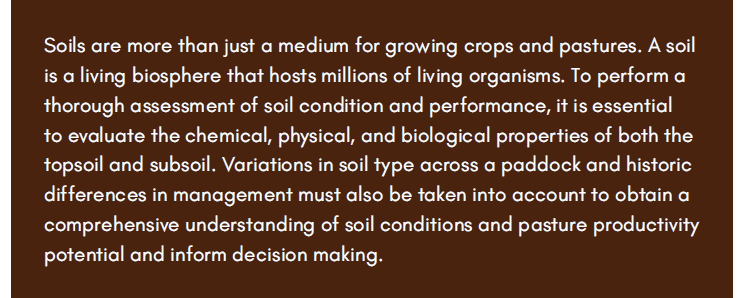The aim of this guide is to provide farmers and agronomists with practical information about soil fertility testing, and to help understand chemical soil analysis data. This guide is not prescriptive, it does not provide one-size fits all recipes. Soil types, paddock histories, and soil conditions vary widely from farm to farm and across a farm. Suboptimal and unreliable pasture responses to inputs often result from using ‘recipes’ or use of incomplete information.
Soil assessments, both chemical and visual can help in identifying chemical and physical limitations to optimal production in grazing systems. This guide can be useful in understanding site-specific soil fertility tests and limitations to pasture productivity due to nutrient deficiencies, imbalances, and limitations due to pH or salinity. It can inform decision making on fertiliser use and soil amendments.
While traditional topsoil tests give some indication of biological and physical soil properties, they do not provide a complete picture. An adequate foundation for a nutrition program can be built upon a soil fertility test, in conjunction with visual assessments and a thorough knowledge of paddock history and production capacity. The observation of visual soil characteristics, e.g., at the time of soil sampling, is crucial to help identify any limitation to pasture growth due to non-chemical constraints.
A range of biological soil tests are available. While they are useful for comparing trial treatments, the interpretation1 of stand-alone soil biology testing results to inform production inputs is not yet fully understood.
Conventional soil fertility tests give information about potentially available nutrients and an indication of nutrient uptake conditions in the root zone. However, a certain nutrient level in the soil does not necessarily mean that the pasture can access all of the nutrients present when needed. Fertiliser programs should be fine-tuned using dry-matter production targets and nutrient removal figures with information on dry matter removal data. Nutrient budgets can be calculated using results from dry matter assessments and stocking rate data. The MLA More Beef From Pastures: Module 3 – Pasture Utilisation has information about using pasture rulers, sticks and meters to monitor production and utilisation.
Further information can be obtained by contacting your regional NRM organisation or an agronomy service provider.
